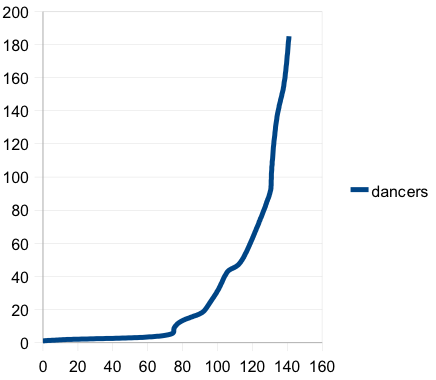How To Dance Your Way To A Crowd
Yes, it’s a YouTube video. But do watch it, it’s a 3 minute 6 second lesson in launching a product or building a community. Filmed during the Sasquatch music festival last weekend, the character in this video danced his way to a following. However, the lesson isn’t about him, it is about the crowd. Here’s a graph of the number of dancers over time (as best as I can do from the clip and a couple of other videos of the event):

Time
It’s a type of graph I use in lots of training sessions. Now, using this video, I can explain the same things in three minutes, without saying a word. Perfect. The video shows what happens to most products from their launch, and to most on-line communities during their introduction and growth phases. It is a classic view of the Rodgers bell curve.
The Innovators
For the first 20 seconds of the video there is just the one person, we shall refer to him from here on in as “the Sasquatch Dancing Man” – or SDM for short. SDM is a little different from the rest of the crowd. If you are unconvinced just check out some of the footage in the related videos at the end of the clip. That’s all I’m saying on the matter!
After those first twenty seconds he isn’t alone, but it is still a small group of people, prepared to do ‘something different’ – they certainly aren’t the crowd – They are the anti-crowd.
Everett Rogers, in his 1962 book Diffusion of Innovations, suggests that innovators make up less than 2.5% of the population. You aren’t going to make a mass market or a huge community out of them, but they certainly get the party started!
The Early Adopters
These folks would like to be the innovators, and probably think of themselves as such. However, they don’t have the appetite to be first with something unproven, but they are happy to be ahead of the crowd. For me, these people are the critical glue in the process, I’ll explain why in a moment.
You see the early adopters kick in at about 80 seconds, just a few at a time. Rogers puts them at 13.5% of the population. They were in the crowd, but only loosely. Now they are out of it, they are with SDM in an elite group of their very own. Hang on, what’s this next?
The Early Majority
There’s a sudden burst. So many new people it’s hard to count. It seems there are more people dancing than not. There’s little social risk in standing up and dancing now. The early majority make up about 34%, so here come…
The Late Majority
They’ve been sitting on the floor, but now they are in danger of being in the social outcrowd, rather than the incrowd. So, up and dance they get. You can see oa tipping point – a term made famous my Malcolm Gladwell’s eponymous book, but pre-dated by much social theory – see Thomas C. Schelling, Micromotives and Macrobehavior – 25 years later, in 2005, he won a Nobel prize. So, suddenly everyone wants to dance. The movement has reached critical mass.
Many, if not most, products and communities never get to reach their tipping point. The transitions from innovators to early adopters to the majority are hard ones to make. The innovators are all about not being in the majority. The majority are all about not being innovators. Bring the right people to the party at the wrong time, and it’s all over.
The challenge of moving between the groups was codified in Geoffrey Moore’s 1991 book “Crossing the Chasm“. A book that I despise, not because of it’s amazingly long title: “Crossing the Chasm: Marketing and Selling High-Tech Products to Mainstream Customers” but because the concept was badly applied by so many product and marketing managers. If you don’t know your innovators from your adopters from the majority, then it is far too easy to end up thinking you are on a different side of the chasm than you really are. The result? #fail as they say on the interwebs.
So, back to SDM. Paul Johnston has a nice take in his post how to start a movement:
- Go somewhere people can see you
- Start Dancing
- Hope that (or invite) 1, 2 and 3 others to join in with your dance… start small – if they’re as crazy as you, don’t worry!
- Attract and invite other small groups to join in
- Make room for growth
- Keep engaging with your new movement even if the music stops
The knack is helping “the crazies” and the growth (the majority) to co-exist with each other, at least for a while. That is why early adopters are so important. They form a kind of neutral glue between the innovators and the majority, transforming “the crazies” into “the crowd” – without them growth is almost impossible.
A side note on point 3 and SDM: I don’t know for sure, but from watching the video I would say the first few dancers knew SDM. You need a few innovators, even just to get started, so don’t ignore them or leave them standing alone.
Although this dance was a one off, products and communities aren’t one shot events. In real-life (if you can call marketing that), the very thing that causes the majority to join, will cause the innovators to leave and go to dance with someone else: The innovators came to be different, while the majority came to be the same. When you’ve cracked that paradox, you’re ready to cross the chasm.


Like your take on this. I completely agree with the stages and I agree that the first few dancers knew SDM.
I actually think your point about marketing not being a “one shot” event as being really key here. There’s no video to show how long he was dancing before this, and no idea as to whether he’d been doing it all day or not. It’s entirely possible that he’d been watched for several minutes or hours prior to being joined (although I don’t think so).
There’s a lot of valuable information here. The simple act of dancing on a Youtube video earns you a following (and no, not only on Twitter). It’s another example of how marketing is a part of life. We can’t help but be drawn to it.
Paul – it’s systems within systems, I think. It is hard to get a pull picture unless you look at things in context, alas we rarely get context! Judging by the other videos from the weekend, I’d say the chap had done a fair amount of dancing on his own – another lesson in its own right: Don’t give up if no-one joins you straight away.
[…] what others are saying about the video here. Tags: Community, humor 5 Comment Share Email This Post « Word of mouth matters […]
[…] Read what others are saying about the video here. […]
There is now a TED talk based on this, by Derek Sivers: How to start a movement